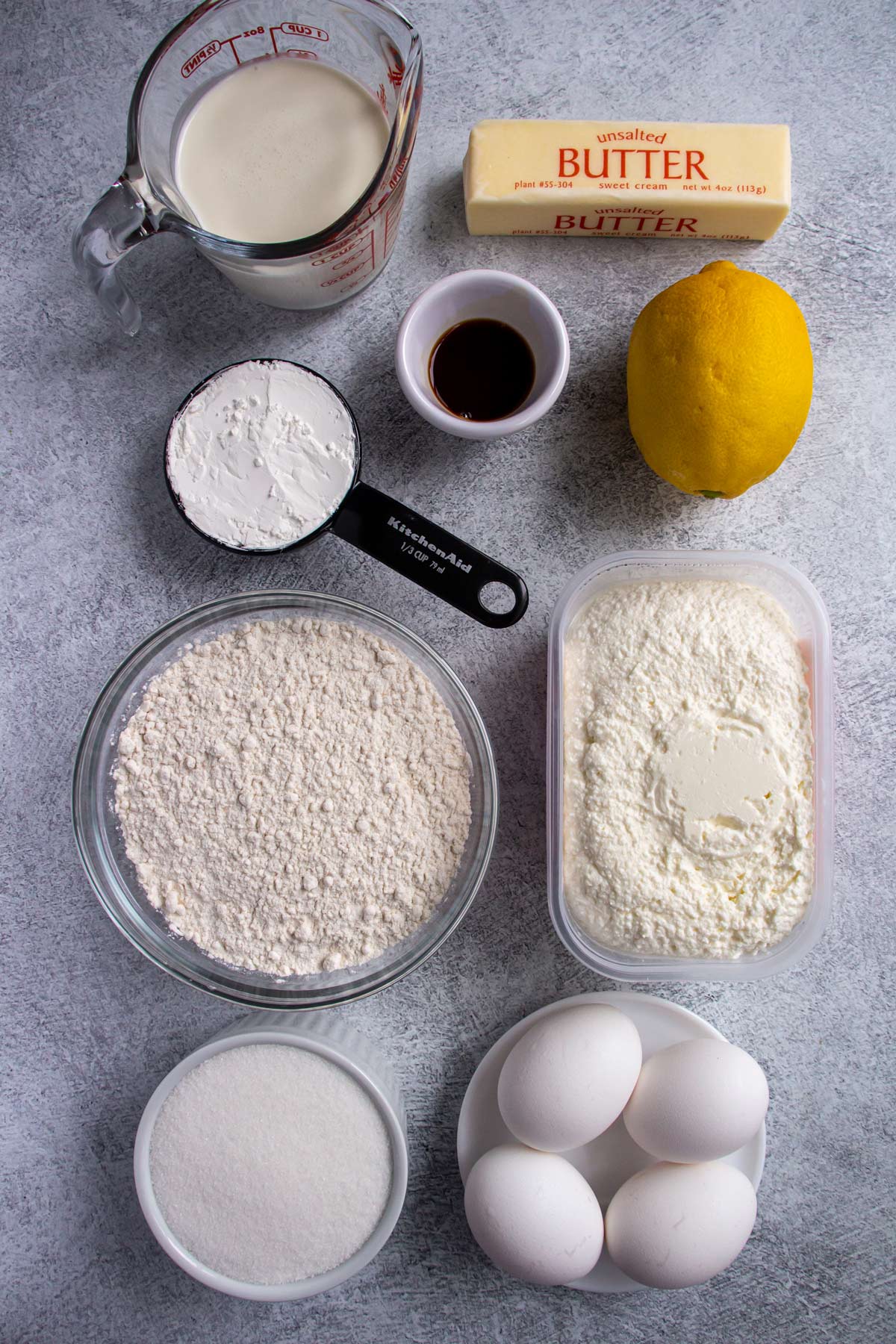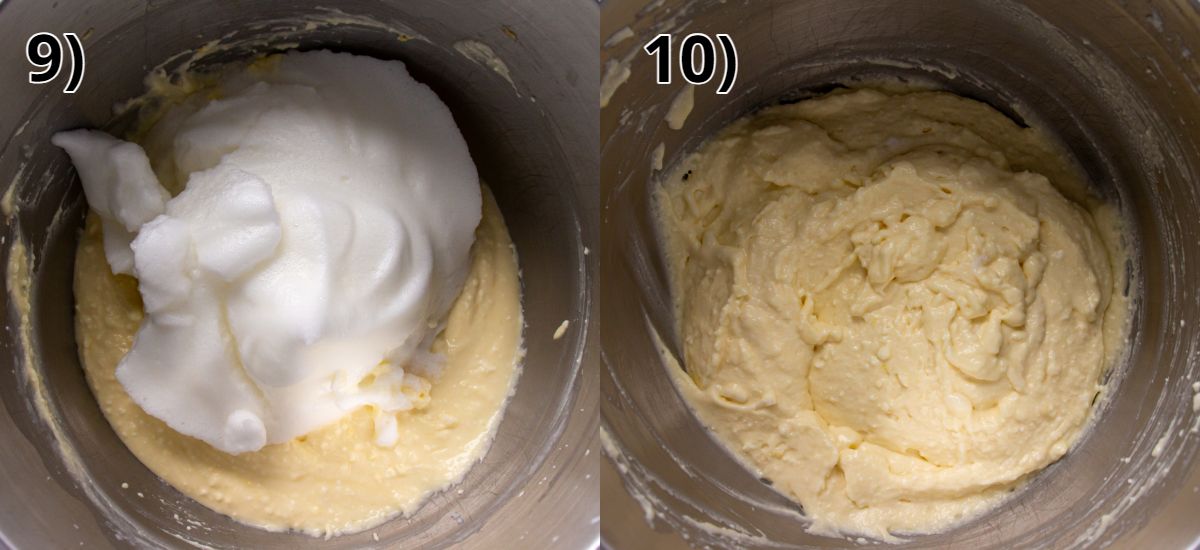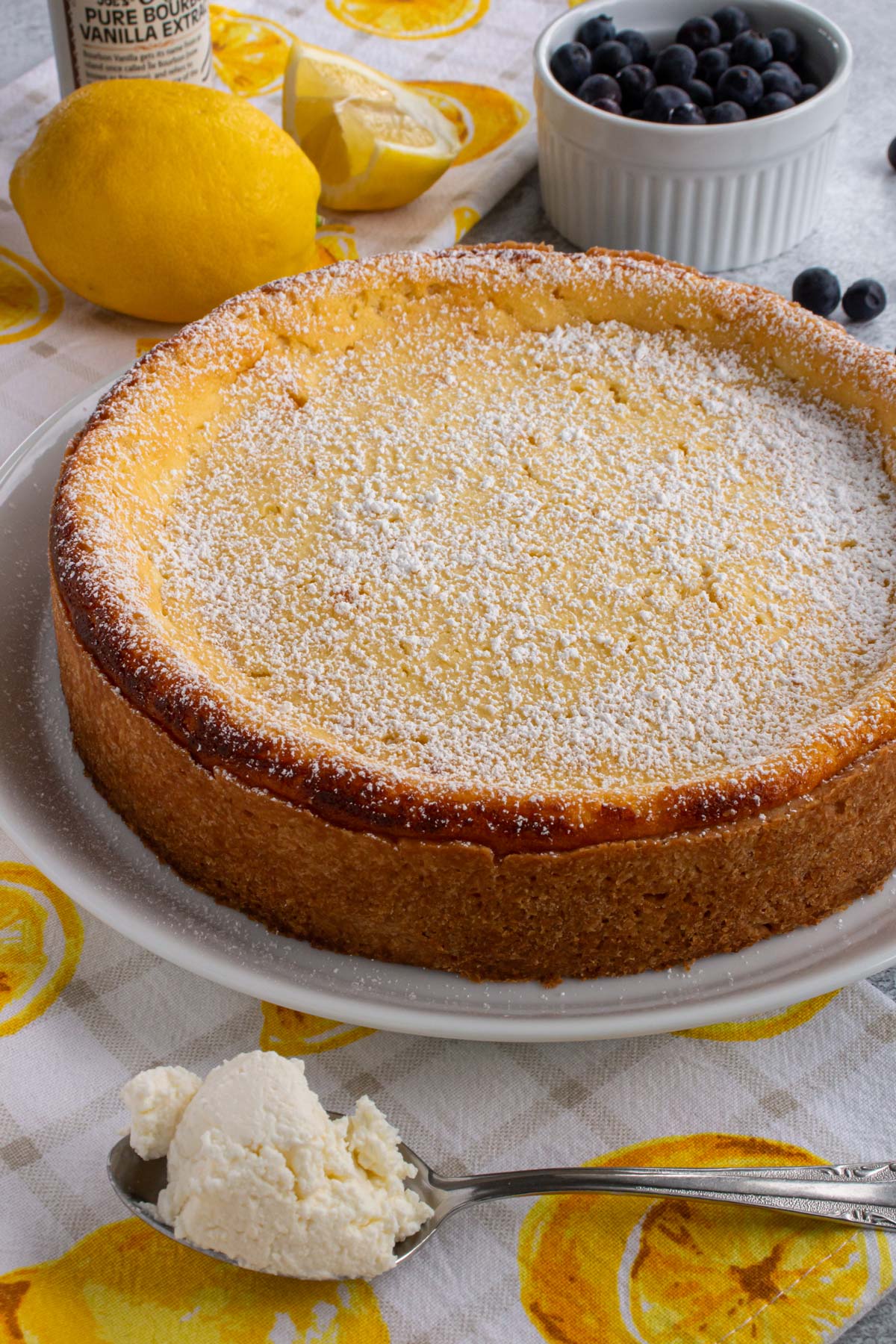Käsekuchen (German Cheesecake) is a light, not-too-sweet but absolutely delicious dessert. It features a lovely shortbread crust and dense quark filling with hints of vanilla and lemon. This easy to make dessert is rustic yet stunning in its own way, perfect for serving to guests.

Although cheesecakes are often considered a staple in American cuisines, particularly New York style cheesecakes, there are other types of international cheesecakes that are absolutely worth trying.
German cheesecake (käsekuchen) is a particular variety that is truly beloved and an excellent addition to one's cheesecake repertoire. The main differences between German cheesecake and American or New York cheesecake are:
- The crust: shortcrust pastry (German) vs. graham cracker or sponge crust (American)
- The type of cheese/dairy used: quark (German) vs. cream cheese (American)
As a result, American or New York cheesecake has a generally richer and creamier texture compared to the denser yet lighter tasting German cheesecake.

American cheesecakes can feature considerably sweet flavorings and toppings. Meanwhile, Käsekuchen is often finished with a light dusting of powdered sugar, although a dollop of fresh whipped cream and berries are also a welcome addition.
There are many variations of käsekuchen including but not limited to these:
- Käsekuchen ohne Boden: crustless quark cheesecake
- Käsekuchen mit Mandarinen: quark cheesecake with canned mandarin oranges
- Russischer Zupfkuchen: chocolate quark cheesecake
- Tränchenkuchen / Käsekuchen mit Baiser: quark cheesecake with a meringue topping
- Some people also stir raisins into their quark cheesecake filling (a bit reminiscent of quark strudel)
Ingredient notes

- Quark: Quark is a type of fresh cheese, sometimes called farmer cheese or curd cheese. It is very traditional in Baltic, Germanic and Slavic-speaking countries. The word "quark" actually translates to "curds" in German. In Austria it's called topfen, in French it's fromage blanc (white cheese) or fromage frais (fresh cheese), in Polish it's twaróg, in Czech and Slovak it's tvaroh, and in Russian it's tvorog (творог). German-style quark has more of a creamy texture than Russian tvarog, which is a bit more dry and crumbly (this is usually what I use for my recipes requiring quark because it's what I can find most easily locally). In the United States you will often find it labeled as farmer's cheese. Any of those labels or names will work for this recipe. If you can't find any of the above, pureed cottage cheese, whole-milk ricotta, or Greek yogurt should be acceptable substitutes though I haven't tested these myself.
- Cornstarch: I don’t normally like using things like pudding powder or taking shortcuts like that, however pudding powder is a very traditional and typical ingredient used in Germany and helps stabilize the filling. Here, instead I’m using cornstarch and vanilla extract to provide that same stability and flavor.
- Eggs: I use large eggs for all my baking. You'll need to separate the eggs so you can whip the egg whites separately to help lighten the filling.
- Lemon Zest: Although the lemon zest is optional, I think it adds a vibrancy to the filling and should be included if possible. The finished result doesn't taste explicitly of lemon, but it provides a layer of flavor that really enhances the käsekuchen.

How to make it
To make the crust, in a large mixing bowl combine flour, sugar, and salt. Add soft butter and an egg (PHOTO 1). Stir to combine and press the dough together until it forms a smooth ball (PHOTO 2).

Wrap the dough in plastic wrap and chill for 30 minutes in the refrigerator while you prepare the filling.
Grease the inside of a 9-inch springform pan. Line the bottom with a parchment paper round and grease the paper. Set aside.

Meanwhile, make the filling. In the bowl of an electric mixer fitted with the paddle attachment, beat together butter and sugar until smooth and creamy (PHOTO 3). Beat in egg yolks (PHOTO 4).

Then beat in cornstarch, vanilla extract, and lemon zest, if using (PHOTOS 5-6).

Add quark and heavy cream, and beat until smooth (PHOTOS 7-8).

In a separate mixing bowl, beat egg whites to stiff peaks (by hand with a whisk or use your electric mixer with the whisk attachment).

Fold the beaten egg whites into the cheesecake batter (PHOTOS 9-10).

Take the chilled dough out of the refrigerator. Break it into smaller pieces and press it into the bottom and sides of the prepared springform pan.

Pour the prepared filling into the crust.

Transfer the pan to the rack on the lower third of a 350°F (180°C) oven, and bake for 60 minutes.
Then crack open the oven door and let it sit in there for another 10 to 15 minutes. The edges should be browned and the center will wobble a bit if you gently shake it, but will set as it cools. The center will also start to settle and sink as it cools.

Remove from the oven and carefully remove the edges of the springform pan. Cool completely on its base at room temperature. Transfer the käsekuchen off the springform pan base onto a serving dish.

Dust the top with powdered sugar and serve with fresh lightly sweetened whipped cream (schlagsahne) and berries, if desired.
Please scroll to the bottom of the post for the full recipe (in a printable recipe card) including ingredient amounts and detailed instructions.

Expert tips
While you can enjoy this German cheesecake the day it's baked, once it is fully cool, ideally, bake it 1 day in advance and refrigerate it overnight for the most optimal results.
Store leftover käsekuchen in an airtight container in the fridge for up to 5 days. You can also individually wrap slices of German cheesecake with plastic wrap, transfer to a freezer bag and freeze for up to 1 month. Thaw completely in the refrigerator before eating.
When pressing the dough into the pan to form the crust, it may only go about 1 ½ inches up the sides of the pan, and that’s fine. Just make sure the edges look even. You can use the bottom and sides of a dry measuring cup to press along the bottom and edges to help even out the thickness.
The total time in the recipe card doesn’t include cooling time, as that can and will vary. The serving size can also vary depending on how small or large you prefer your slices. The slices in the photos are larger (based on cutting into 8 servings), but the nutritional information is based on 12 slightly smaller slices of käsekuchen.

Other recipes you may like
- Topfenstrudel (Quark Strudel / Cheese Strudel)
- Donauwelle Kuchen (Danube Wave Cake / Snow White Cake)
- Rotweinkuchen (German Red Wine Cake)
- Kirschenmichel (German Bread Pudding with Cherries)
- Heidesand (German Brown Butter Shortbread Cookies)
- Strawberry Cheesecake Bread Pudding
- Schinkengipfeli (Swiss Ham and Quark Croissants)
Tried this recipe? Please leave a star ⭐️⭐️⭐️⭐️⭐️ rating in the recipe card below and/or a review in the comments section further down the page. You can also follow me on social media on Facebook, Instagram, and Pinterest!

Käsekuchen (German Cheesecake)
Ingredients
Crust:
- 190 grams (1 ½ cups) all-purpose flour
- 50 grams (¼ cup) granulated sugar
- Pinch kosher salt
- 85 grams (6 tablespoons / 3 ounces) unsalted butter room temperature
- 1 large egg beaten
Filling:
- 55 grams (4 tablespoons / 2 ounces) unsalted butter room temperature
- 150 grams (¾ cup) granulated sugar
- 3 large eggs separated
- 45 grams (⅓ cup) cornstarch
- 2 teaspoons vanilla extract
- 1 teaspoon grated lemon zest from about ½ a large lemon (optional)
- 450 grams (2 cups) quark or farmer cheese
- ¾ cup heavy cream
Instructions
Crust:
- Preheat the oven to 350°F (180°C) and place the rack in the lower third of the oven. Grease the inside of a 9-inch springform pan. Line the bottom with a parchment paper round and grease the paper. Set aside.
- In a large mixing bowl combine the flour, sugar, and salt. Add the butter and the egg.
- Stir to combine and press the dough together until it forms a smooth ball. Wrap the dough in plastic wrap and chill for 30 minutes in the refrigerator while you prepare the filling.
Filling:
- In the bowl of an electric mixer fitted with the paddle attachment, beat together the butter and sugar until smooth and creamy, about 1 to 2 minutes. Beat in the egg yolks, then the cornstarch, vanilla extract, and lemon zest, if using, and beat to combine.
- Add the quark and heavy cream, and beat until smooth. In a separate mixing bowl, beat the egg whites to stiff peaks (by hand with a whisk or use your electric mixer with the whisk attachment). This will take about 2 to 3 minutes with an electric stand mixer at medium-high speed. Fold the beaten egg whites into the cheesecake batter.
Assembly and Baking:
- Take the chilled dough out of the refrigerator. Break it into smaller pieces and press it into the bottom and sides of the prepared springform pan.
- Pour the prepared filling into the crust. Transfer the pan to the rack on the lower third of the oven, and bake for 60 minutes.
- Then crack open the oven door and let it sit in there for another 10 to 15 minutes. The edges should be browned and the center will wobble a bit if you gently shake it, but will set as it cools. The center will also start to settle and sink as it cools.
- Remove from the oven and carefully remove the edges of the springform pan (if greased properly they should come right off). Cool completely on its base at room temperature. Transfer the käsekuchen off the springform pan base (peel off the parchment paper as well) onto a serving dish.
- Dust the top with powdered sugar and serve with fresh lightly sweetened whipped cream (schlagsahne) and berries, if desired.
Notes
- Ideally, bake this German cheesecake 1 day in advance and refrigerate it overnight for the most optimal results.
- Store leftover käsekuchen in an airtight container in the fridge for up to 5 days. You can also individually wrap slices of German cheesecake with plastic wrap, transfer to a freezer bag and freeze for up to 1 month. Thaw completely in the refrigerator before eating.
- When pressing the dough into the pan to form the crust, it may only go about 1 ½ inches up the sides of the pan, and that’s fine. Just make sure the edges look even. You can use the bottom and sides of a dry measuring cup to press along the bottom and edges to help even out the thickness.
- The total time in the recipe card doesn’t include cooling time, as that can and will vary. The serving size can also vary depending on how small or large you prefer your slices, but the nutritional information is based on 12 slices of käsekuchen.
- Quark is a type of fresh cheese, sometimes called farmer cheese or curd cheese. In Austria it's called topfen, in French it's fromage blanc (white cheese) or fromage frais (fresh cheese), in Polish it's twaróg, in Czech and Slovak it's tvaroh, and in Russian it's tvorog (творог). German-style quark has more of a creamy texture than Russian tvarog, which is a bit more dry and crumbly (but this is usually what I use for my recipes requiring quark because it's what I can find). In the United States you will often find it labeled as farmer's cheese. Any of those labels or names will work for this recipe. If you can't find any of the above, pureed cottage cheese, whole-milk ricotta, or Greek yogurt should be acceptable substitutes though I haven't tested these myself.
Nutrition
*All nutritional information is based on third-party calculations and should be considered estimates. Actual nutritional content will vary with brands used, measuring methods, portion sizes and more.*






Comments
No Comments